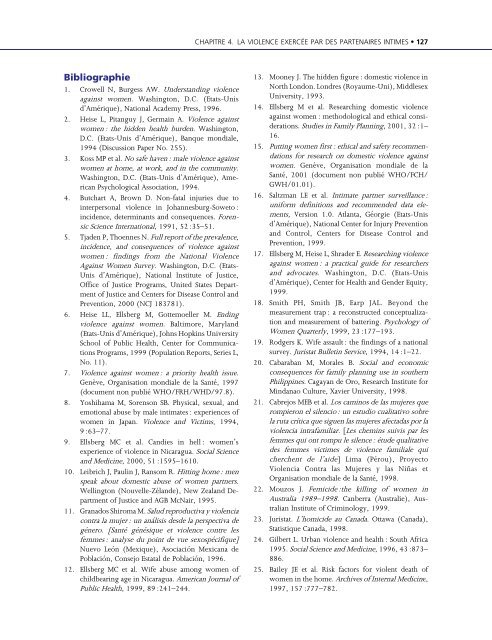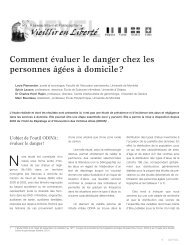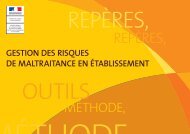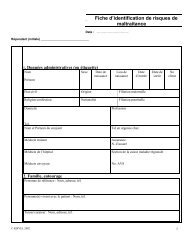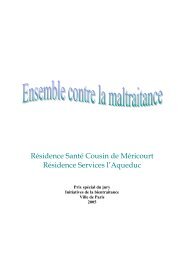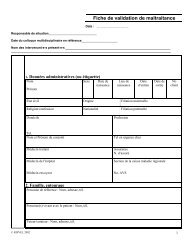Rapport mondial sur la violence et la santé
Rapport mondial sur la violence et la santé
Rapport mondial sur la violence et la santé
Create successful ePaper yourself
Turn your PDF publications into a flip-book with our unique Google optimized e-Paper software.
CHAPITRE 4. LA VIOLENCE EXERCÉE PAR DES PARTENAIRES INTIMES . 127Bibliographie1. Crowell N, Burgess AW. Understanding <strong>violence</strong>against women. Washington, D.C. (Etats-Unisd’Amérique), National Academy Press, 1996.2. Heise L, Pitanguy J, Germain A. Violence againstwomen : the hidden health burden. Washington,D.C. (Etats-Unis d’Amérique), Banque <strong>mondial</strong>e,1994 (Discussion Paper No. 255).3. Koss MP <strong>et</strong> al. No safe haven : male <strong>violence</strong> againstwomen at home, at work, and in the community.Washington, D.C. (Etats-Unis d’Amérique), AmericanPsychological Association, 1994.4. Butchart A, Brown D. Non-fatal injuries due tointerpersonal <strong>violence</strong> in Johannesburg-Sow<strong>et</strong>o :incidence, d<strong>et</strong>erminants and consequences. ForensicScience International, 1991, 52 :35–51.5. Tjaden P, Thoennes N. Full report of the prevalence,incidence, and consequences of <strong>violence</strong> againstwomen : findings from the National ViolenceAgainst Women Survey. Washington, D.C. (Etats-Unis d’Amérique), National Institute of Justice,Office of Justice Programs, United States Departmentof Justice and Centers for Disease Control andPrevention, 2000 (NCJ 183781).6. Heise LL, Ellsberg M, Gottemoeller M. Ending<strong>violence</strong> against women. Baltimore, Mary<strong>la</strong>nd(Etats-Unis d’Amérique), Johns Hopkins UniversitySchool of Public Health, Center for CommunicationsPrograms, 1999 (Popu<strong>la</strong>tion Reports, Series L,No. 11).7. Violence against women : a priority health issue.Genève, Organisation <strong>mondial</strong>e de <strong>la</strong> Santé, 1997(document non publié WHO/FRH/WHD/97.8).8. Yoshihama M, Sorenson SB. Physical, sexual, andemotional abuse by male intimates : experiences ofwomen in Japan. Violence and Victims, 1994,9 :63–77.9. Ellsberg MC <strong>et</strong> al. Candies in hell : women’sexperience of <strong>violence</strong> in Nicaragua. Social Scienceand Medicine, 2000, 51 :1595–1610.10. Leibrich J, Paulin J, Ransom R. Hitting home : menspeak about domestic abuse of women partners.Wellington (Nouvelle-Zé<strong>la</strong>nde), New Zea<strong>la</strong>nd Departmentof Justice and AGB McNair, 1995.11. Granados Shiroma M. Salud reproductiva y violenciacontra <strong>la</strong> mujer : un análisis desde <strong>la</strong> perspectiva degénero. [Santé génésique <strong>et</strong> <strong>violence</strong> contre lesfemmes : analyse du point de vue sexospécifique]Nuevo León (Mexique), Asociación Mexicana dePob<strong>la</strong>ción, Consejo Estatal de Pob<strong>la</strong>ción, 1996.12. Ellsberg MC <strong>et</strong> al. Wife abuse among women ofchildbearing age in Nicaragua. American Journal ofPublic Health, 1999, 89 :241–244.13. Mooney J. The hidden figure : domestic <strong>violence</strong> inNorth London. Londres (Royaume-Uni), MiddlesexUniversity, 1993.14. Ellsberg M <strong>et</strong> al. Researching domestic <strong>violence</strong>against women : m<strong>et</strong>hodological and <strong>et</strong>hical considerations.Studies in Family P<strong>la</strong>nning, 2001, 32 :1–16.15. Putting women first : <strong>et</strong>hical and saf<strong>et</strong>y recommendationsfor research on domestic <strong>violence</strong> againstwomen. Genève, Organisation <strong>mondial</strong>e de <strong>la</strong>Santé, 2001 (document non publié WHO/FCH/GWH/01.01).16. Saltzman LE <strong>et</strong> al. Intimate partner <strong>sur</strong>veil<strong>la</strong>nce :uniform definitions and recommended data elements,Version 1.0. At<strong>la</strong>nta, Géorgie (Etats-Unisd’Amérique), National Center for Injury Preventionand Control, Centers for Disease Control andPrevention, 1999.17. Ellsberg M, Heise L, Shrader E. Researching <strong>violence</strong>against women : a practical guide for researchersand advocates. Washington, D.C. (Etats-Unisd’Amérique), Center for Health and Gender Equity,1999.18. Smith PH, Smith JB, Earp JAL. Beyond themea<strong>sur</strong>ement trap : a reconstructed conceptualizationand mea<strong>sur</strong>ement of battering. Psychology ofWomen Quarterly, 1999, 23 :177–193.19. Rodgers K. Wife assault : the findings of a national<strong>sur</strong>vey. Juristat Bull<strong>et</strong>in Service, 1994, 14 :1–22.20. Cabaraban M, Morales B. Social and economicconsequences for family p<strong>la</strong>nning use in southernPhilippines. Cagayan de Oro, Research Institute forMindanao Culture, Xavier University, 1998.21. Cabrejos MEB <strong>et</strong> al. Los caminos de <strong>la</strong>s mujeres querompieron el silencio : un estudio cualitativo sobre<strong>la</strong> ruta crítica que siguen <strong>la</strong>s mujeres afectadas por <strong>la</strong>violencia intrafamiliar. [Les chemins suivis par lesfemmes qui ont rompu le silence : étude qualitativedes femmes victimes de <strong>violence</strong> familiale quicherchent de l’aide] Lima (Pérou), ProyectoViolencia Contra <strong>la</strong>s Mujeres y <strong>la</strong>s Niñas <strong>et</strong>Organisation <strong>mondial</strong>e de <strong>la</strong> Santé, 1998.22. Mouzos J. Femicide :the killing of women inAustralia 1989–1998. Canberra (Australie), AustralianInstitute of Criminology, 1999.23. Juristat. L’homicide au Canada. Ottawa (Canada),Statistique Canada, 1998.24. Gilbert L. Urban <strong>violence</strong> and health : South Africa1995. Social Science and Medicine, 1996, 43 :873–886.25. Bailey JE <strong>et</strong> al. Risk factors for violent death ofwomen in the home. Archives of Internal Medicine,1997, 157 :777–782.


